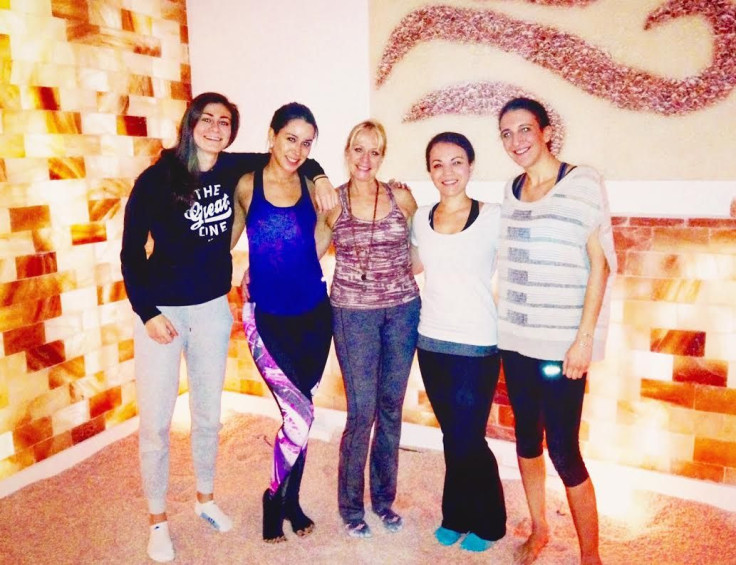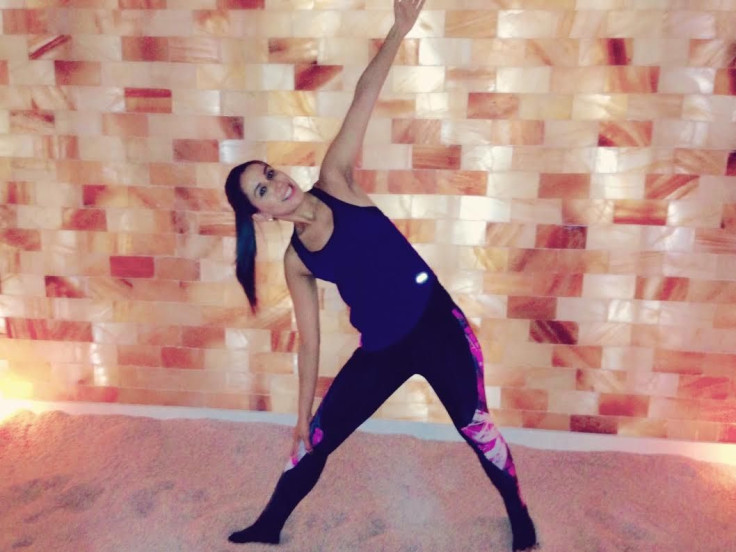Dry Salt Therapy Benefits: How Salty Yoga In Pink Himalayan Salt Helped My Shallow Breathing

Shallow, quick breaths are common among those of us with desk jobs. Eight hours a day, five times a week, we hunch over our computers with very limited movement, except for the occasional coffee run or lunch. Yoga is touted for its benefits in improving posture and flexibility, something us desk workers need. As a yoga enthusiast, I wanted to dabble in an alternative form of yoga, and steer away from the conventional yoga pilates. Enter salty yoga.
On Monday morning, my colleagues and I were ready to try this new fitness trend. Before entering "Breathe," a salt room inside Oasis Day Spa in New York City, we didn't know much about what we were getting into. Most of us were skeptical, but intrigued by the odd pairing of the ancient health practice and salt.
Ready to conquer the day with salty yoga, we walked into the delicate rose-pink room filled with salt. Immediately, I felt a sense of tranquility in the small salt chamber as the yoga mats were laid parallel next to one another. Yoga instructor Ellen Patrick greeted us with a smile, ready to start our 50-minute session. This was a much welcome change from heading to my desk in our office in the bustling Financial District.
Halotherapy: Breathing In Salt
Although a fairly new practice in the U.S., salt therapy has been practiced in Europe and the Middle East. Salt baths and caves were used as a means to improve our immune system, allergies, alleviate skin conditions, and even suppress the common cold and flu. Practitioners claim the pink Himalayan salt is behind these “healing powers.”
It’s impossible not to notice the beautiful pink Himalayan salt all over the room and fixtures. This type of salt is unrefined, unprocessed raw salt mined by hand from caves that formed 250 million years ago as ocean salt settled into geologic pockets. It also has antifungal. anti-inflammatory, antibacterial, and antiviral properties, according to Patrick.
Pink Himalayan salt emits negative ions, which help clear the air of mold spores, pollen, pet dander, odors, cigarette smoke, bacteria, viruses, dust and other hazardous airborne particles. Negative ions work by attaching themselves to positively charged particles in large numbers. Computers, TVs, and cellphones all release positive ions, which can lead us to feel more agitated.
In particular, salty therapy treatments have been touted as a helpful preventative measure to avoid the common cold, some respiratory viruses/infections, and some other ear, nose, and throat conditions. There's not a wealth of scientific literature to support these claims, but some studies suggest breathing in salt via halotherapy does provide a few benefits.
A 2006 study in The New England Journal of Medicine found inhaling salt-infused vapor improved breathing for 24 participants with cystic fibrosis. Patients experienced an increase in volume of airway surface liquid, restored mucus clearance, and improved lung function.
As we sat down on our yoga mats, the halogenerator turned on, spewing tiny salt particles into the air. You can see the salt on your clothes and even taste it on your lips. Aside from the salt component, I thought this was like regular yoga; I was ready to put my flexibility to the test.
Sitting on the yoga mat, I assumed a slouched posture as when I sit at my desk. When we sit at our desks, the diaphragm doesn't really expand, which causes our breath to come shorter and faster. Typically, this is a stress response that signals the brain that we're feeling anxious, although we're not. In the beginning of the class, Patrick emphasized we were going to focus on expanding our diaphragm for better breathing.
In yoga, being mindful of your breath is essential, however, it's not usually the main focus of the class. For example, in yoga pilates, I focus more on working out my core and back, rather than my breathing. I focus on building strength and flexibility by increasing my range of motion.
Contrastingly, in salty yoga, the focus is on "freeing the lungs and entire thoracic cavity which makes this class especially useful for those with respiratory issues and for tuning the 4th chakra (heart or anahata chakra.)" Patrick told Medical Daily.
To my surprise, the focus wasn't on correct posture, but on our breathing technique. At the beginning of the class, I had a short, shallow, and quick breath, but as I became more aware of my breathing patterns, I began to expand my diaphragm more as I took longer, deeper breaths.
Switching positions from downward dog to warrior II, I moved with more ease, and every breath led to a better expansion. My colleagues also felt they could breathe easier with every step they took.
Medical Daily reporter Kelsey Drain, who practices yoga weekly, said:
“For me, the class solidified the importance of deep breaths and shifted my focus to mindfulness, rather than building strength.”
Meanwhile, yoga novice and Medical Daily reporter Dana Dovey, was pleasantly surprised by the unique experience:
"Not only was Ellen's instructions easy to follow, but the combination of the salt in the air and the salt fixtures throughout the room created an extremely calming effect. I felt energized, happy, and ready to take on my day after my session."
A 2006 study in the European Journal of Allergy and Clinical Immunology found people with asthma reported breathing easier after several weeks of regular halotherapy treatments. Salt therapy worked as an add-on to a low to moderate dose of inhaled steroids. The researchers believe this duo could be beneficial for other respiratory illnesses.
Salt for Skin
Salty Yoga does more than just help our respiration, it can allegedly alleviate several skin conditions. I have naturally oily skin that is prone to buildup, especially if I sweat during exercise. However, during salty yoga, my skin did not appear more oily than usual, and inflammation was kept at bay.
Medical Daily reporter Elana Glowatz also experienced a similar result:
"The salt itself was a huge draw for me because I have oily skin and I find that my skin and hair feel amazing after I've spent some time in salty air, like when I'm near the ocean. I wasn't disappointed after our session — the salt in the air made my skin feel smooth and clean."
According to Breathe’s website: “the non-inhaled particles landing on the skin help to balance pH and induce the reparative and regenerative processes in the skin, increasing rigidity and stimulating cell growth and microcirculation.”
Life Post-Salty Yoga
I got a workout doing salty yoga, but I didn’t break a sweat like I expected to. It was a workout for my lungs; I learned to have a nice long, deep breath throughout movement, which is vital for working and living in New York City. After salty yoga, my commute back to work felt better than other days. There were still train delays, long lines for coffee, and unbearable traffic, but I felt better equipped for conquering the day. I was in control of my breath, rather than having outside circumstances dictate how I should breathe.
I’m more conscious of my breath, which will help me with other forms of yoga and exercises.

Some people may not feel the effects of salty yoga right away, but Patrick explains “it's like a toothbrush for your lungs and skin, everyone can (and will) benefit.”
Salt therapy may enhance athletic endurance and accelerate recovery time, prevent you from catching common cold or flu, help slow the aging process, increase overall wellness, help relax and alleviate stress and help you sleep better.
So, how many times until you start seeing results?
It depends on your goal; if you want to achieve relaxation, to de-stress, and/or to increase your overall mood and wellness, Patrick suggests you may visit as frequently as desired. For mild conditions, such as colds, flu symptoms, ear infections, or other temporary ENT or lung discomforts, 3 to 8 sessions may prove to be very effective. Meanwhile, for chronic respiratory and dermatological conditions, such as cystic fibrosis, asthma, allergies, psoriasis, among many others, you may find 3 times a week on an ongoing basis will help alleviate or reduce symptoms, according to Patrick.
Want to give salty yoga a try for yourself?
Breathe's offer code BEFAM will get you 50 percent off their Intro Package ($25 for 5 sessions).
Namaste.



























